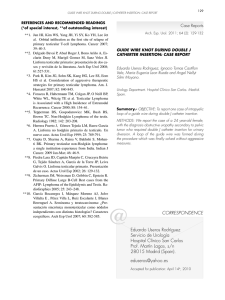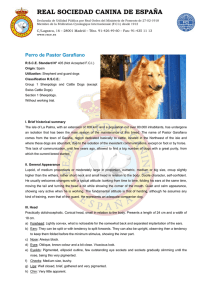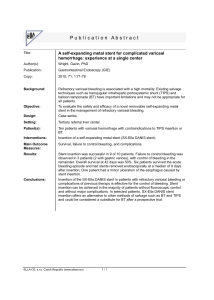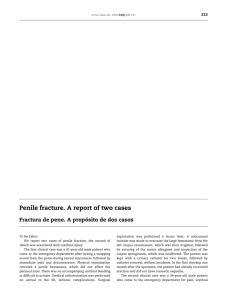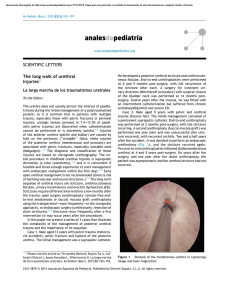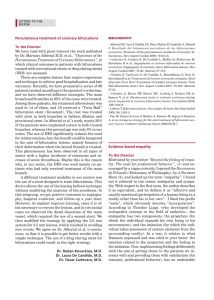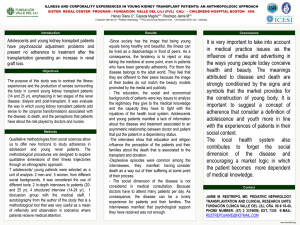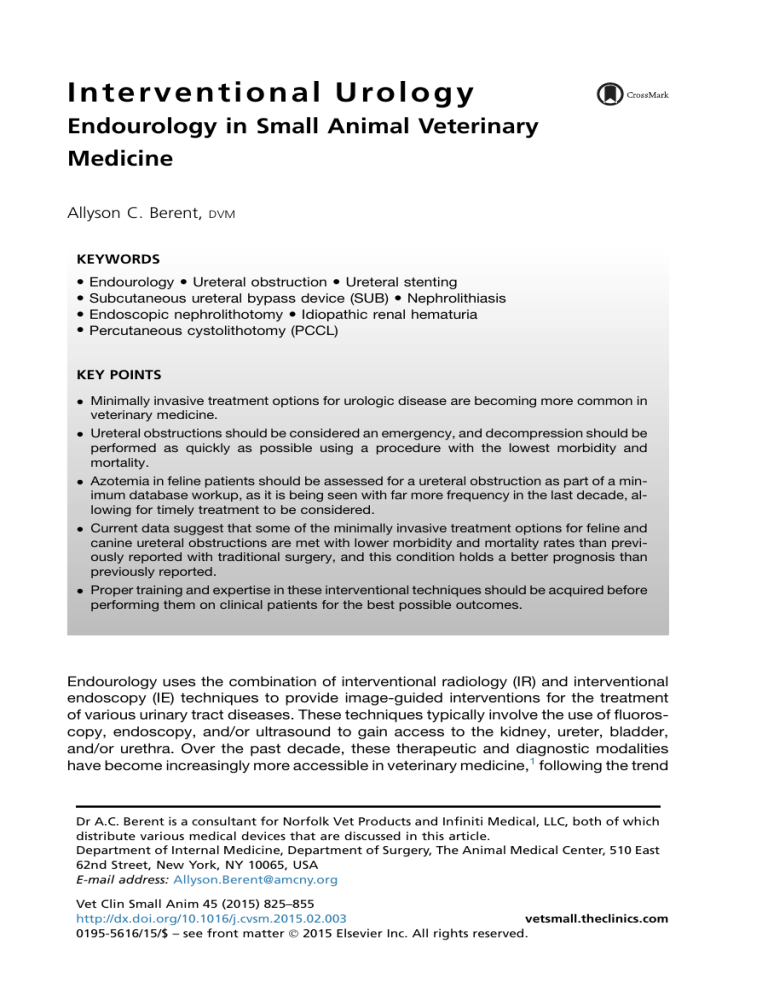
I n t e r v e n t i o n a l U rol o g y Endourology in Small Animal Veterinary Medicine Allyson C. Berent, DVM KEYWORDS Endourology Ureteral obstruction Ureteral stenting Subcutaneous ureteral bypass device (SUB) Nephrolithiasis Endoscopic nephrolithotomy Idiopathic renal hematuria Percutaneous cystolithotomy (PCCL) KEY POINTS Minimally invasive treatment options for urologic disease are becoming more common in veterinary medicine. Ureteral obstructions should be considered an emergency, and decompression should be performed as quickly as possible using a procedure with the lowest morbidity and mortality. Azotemia in feline patients should be assessed for a ureteral obstruction as part of a minimum database workup, as it is being seen with far more frequency in the last decade, allowing for timely treatment to be considered. Current data suggest that some of the minimally invasive treatment options for feline and canine ureteral obstructions are met with lower morbidity and mortality rates than previously reported with traditional surgery, and this condition holds a better prognosis than previously reported. Proper training and expertise in these interventional techniques should be acquired before performing them on clinical patients for the best possible outcomes. Endourology uses the combination of interventional radiology (IR) and interventional endoscopy (IE) techniques to provide image-guided interventions for the treatment of various urinary tract diseases. These techniques typically involve the use of fluoroscopy, endoscopy, and/or ultrasound to gain access to the kidney, ureter, bladder, and/or urethra. Over the past decade, these therapeutic and diagnostic modalities have become increasingly more accessible in veterinary medicine,1 following the trend Dr A.C. Berent is a consultant for Norfolk Vet Products and Infiniti Medical, LLC, both of which distribute various medical devices that are discussed in this article. Department of Internal Medicine, Department of Surgery, The Animal Medical Center, 510 East 62nd Street, New York, NY 10065, USA E-mail address: [email protected] Vet Clin Small Anim 45 (2015) 825–855 http://dx.doi.org/10.1016/j.cvsm.2015.02.003 vetsmall.theclinics.com 0195-5616/15/$ – see front matter Ó 2015 Elsevier Inc. All rights reserved. 826 Berent of what is considered standard of care in human medicine.1–32 The traditional types of therapies using IR/IE techniques are associated with the relief of various urinary tract obstructions (ureteral stenting, subcutaneous ureteral bypass [SUB] device, urethral stenting), removal of urinary tract stones (lithotripsy, percutaneous nephrolithotomy [PCNL], percutaneous cystolithotomy [PCCL]), cessation of urinary tract bleeding (sclerotherapy, nephroscopy with electrocautery), and intra-arterial (IA) delivery of therapeutics to obtain higher local doses (stem cell therapy). There are many advantages to IR/IE techniques when compared with traditional surgical alternatives. The reduced perioperative morbidity and mortality rates, shorter hospital stays, and availability of new therapeutic options when no treatments were traditionally safe or available are the main benefits of this technology. The main disadvantages are the requirement for proper technical training, the need for specialized equipment, and the steep learning curve. With the high incidence of upper and lower urinary tract disease, combined with the invasiveness and morbidity associated with traditional techniques, the use of minimally invasive techniques is appealing. This article reviews some of the most common interventional procedures currently being performed in small animal veterinary patients. When possible, the reported outcomes, success rates, complications, and survival times are discussed using evidenced-based medicine. KIDNEY Interventional Approach to Nephrolithiasis The need for nephrolith removal is rarely necessary in veterinary medicine. Nephroliths are considered problematic when they are (1) causing intractable pyelonephritis (despite appropriate medical management or stone dissolution diet when indicated), (2) causing a ureteral outflow tract obstruction associated with hydronephrosis, or (3) enlarging and overtaking the renal parenchyma resulting in progressive renal damage. It is important to note that it is suspected that most nephroliths do not cause pain or discomfort unless they are associated with pyelonephritis, pyonephrosis, or a ureteral outflow obstruction, so the need for removal is rare. There is some concern that dogs with progressive renal insufficiency may benefit from stone removal, but this is yet to be proven. Traditional open surgical options to treat problematic nephroliths (nephrotomy or ureteronephrectomy) are associated with frequent complications and high longterm morbidity.33,34 In a clinical study, approximately 43% of dogs had some stone fragments remaining after surgery with a 23% complication rate associated with the procedure.33 In that same study, 67% of dogs developed renal azotemia following a nephrectomy. In a study of normal cats in which a nephrotomy was performed,34 there was a 10% to 20% decrease in the glomerular filtration rate (GFR). In clinical patients, with prior renal injury associated with uroliths, compensatory mechanisms are often exhausted before diagnosis, so similar surgical interventions could have a more detrimental effect on renal function, emphasizing that one must be careful extrapolating these surgical results to clinical patients with upper tract uroliths, renal damage, and preexisting renal disease. In the author’s opinion, open surgical nephrotomy is reserved for removal of large, obstructed nephroliths in dogs only when other options, such as extracorporeal shock-wave lithotripsy (ESWL) or PCNL, are not available. Open nephrotomy for removal of nonobstructive nephroliths in cats is not recommended particularly because the data confirming any benefit from nephrolith removal are lacking, and data confirming a negative effect on renal function exist.34,35 Interventional Urology Extracorporeal shock-wave lithotripsy ESWL refers to fragmentation of stones into small pieces using shocks generated outside of the body (Fig. 1). It is typically used for nephroliths and ureteroliths in dogs and not currently recommended in cats3–5 because of their stone type, which is considered refractory to ESWL fragmentation,36 and the small size of their ureteral lumen (0.3 mm), making stone fragments unlikely to pass. ESWL uses external shock waves that pass through a water medium, through the soft tissues of patients, and are directed onto the stone using fluoroscopic guidance. The stone is then shocked anywhere from 1000 to 3500 times at different energy levels to break up a stone into small fragments that are then allowed to pass down the ureter and into the urinary bladder passively. The debris is permitted to traverse the ureter over a 2- to 12-week period. ESWL is thought to be very safe for the kidney, though subclinical intrarenal hemorrhage does occur.3–5 Studies have shown minimal effect on the GFR in both the shortand long-term after ESWL.37,38 The availability of ESWL for veterinary patients in limited and currently only available at Purdue University (Dr Larry Adams) and The Animal Medical Center, New York City (Dr Allyson Berent). In dogs, ESWL fragmentation is very successful, though up to 30% of dogs will require more than one treatment to achieve adequate fragmentation of nephroliths.3–5 The mortality rate with ESWL is less than 1%, with the most common complication being the development of a transient ureteral obstruction in approximately 10% of cases.3–5 The risk of ureteral obstruction may be minimized by placement of a ureteral stent before ESWL treatment to allow for passive ureteral dilation and prevent obstruction during fragment passage.39 Pancreatitis is another possible complication with ESWL, which was documented in 2% to 3% of cases.40 For stones larger than 1.5 cm, endoscopic nephrolithotomy (ENL) is often recommended in both human and veterinary patients when possible (see later discussion). Fig. 1. ESWL in a dog with nephrolithiasis. 827 828 Berent Endoscopic nephrolithotomy ENL can either be performed percutaneously (PCNL) or surgically assisted (surgically assisted ENL [SENL]) and is available in veterinary medicine for problematic nephroliths larger than 1.5 cm or of cystine composition, which are ESWL resistant (Fig. 2). This procedure has been shown to have minimal effect on renal function in both children and adults with large stone burdens, solitary kidneys, or renal insufficiency.41 PCNL is reported to be the most renal sparing when compared with ESWL, laparoscopic-assisted nephrotomy, and traditional nephrotomy.37,41,42 This finding is most likely because of the lack of nephron transection and the access point based on parenchymal dilation and spreading, sparing functional tissue. PCNL/SENL was recently reported in an abstract of 9 dogs and 1 cat.7 A combination of ultrasound, nephroscopy, fluoroscopy, and intracorporeal lithotripsy (electrohydraulic, ultrasonic, pneumatic and/or holmium:YAG [Hol:YAG] laser lithotripsy) is needed to remove the entire nephrolith. Patient size was not seen to be a factor in success, but proper training and appropriate equipment is needed for a successful outcome. The success rate of PCNL has been documented at 90% to 100% in both the adult and the pediatric human populations, and the author has experienced the same in veterinary patients. Fig. 2. ENL in a dog with large calcium oxalate nephroliths. (A) Percutaneous access into the renal pelvis with a sheath (yellow arrow). (B) Nephroscope through the sheath into the renal pelvis. (C) Lithotriptor (white asterisk), through the working channel of the nephroscope breaking the stone (arrow) inside the renal pelvis. (D) Renal pelvis after all stone fragments removed. Interventional Urology Idiopathic renal hematuria Essential (idiopathic) renal hematuria (IRH) is a rare condition in which a focal area of bleeding in the upper urinary tract results in severe chronic hematuria and the potential for iron deficiency anemia and blood clot formation, which can ultimately result in a ureteral or urethral obstruction. In people, a hemangioma, angioma, or vascular malformation may be visualized ureteroscopically in the renal pelvis, and treatment via electrocautery can be accomplished.43–47 IRH is diagnosed most commonly in very young large-breed dogs and occurs bilaterally in 25% to 33% of affected patients. For unilateral disease, usually confirmed by cystoscopy, ureteronephrectomy was previously recommended to minimize blood loss. Nephrectomy should be considered contraindicated because of the risk of progressive bilateral disease, the lack of disease of the functional renal tissue, and the availability and ease of kidney-sparing techniques. Sclerotherapy can be performed with the use of silver nitrate and povidone-iodine as cauterizing agents that can be infused into the renal pelvis. This treatment can be done in any dog (male or female), regardless of size. Under cystoscopic and fluoroscopic guidance, the cauterizing agent is infused into the renal pelvis through a ureteral occlusion balloon catheter (Fig. 3). In a recent study8 in which sclerotherapy was used for the treatment of IRH complete cessation of macroscopic hematuria occurred in 4 of 6 dogs within a median of 6 hours (range, postoperative to 7 days). Two additional dogs improved, one moderately and one substantially. None of the dogs required nephrectomy. To date the author has performed this procedure is more than 20 dogs with success rates at approximately 80%. Ureteroscopy for electrocautery has only been performed in a small number of patients, and this is typically reserved for those that have failed sclerotherapy and have a large enough ureter to accept the 8-F ureteroscope (Fig. 4). There were no complications noted from the procedure when a stent was placed after infusion. Fig. 3. IRH in a female dog during sclerotherapy. The dog is in dorsal recumbency. (A) Cystoscopic image of the left ureterovesicular junction with blood coming out of the ureter. (B) A ureteral catheter up the ureter visualized cystoscopically. (C) A ureteropyelogram through the UPJ balloon during sclerotherapy infusion. Not the balloon occluding the ureters (black arrow). 829 830 Berent Fig. 4. Ureteroscopy in a dog for IRH during electrocautery. (A) Fluoroscopic image of a ureteroscope in the left ureter at the ureteropelvic junction. (B) Renal pelvis visualized during ureteroscopy visualizing the bleeding lesion (black arrow). (C) Electrocautery probe cauterizing the bleeding lesion in the renal pelvis. Intra-arterial Stem Cell Delivery for Chronic Kidney Disease/Protein Losing Nephropathy Infusion of autologous mesenchymal stem cells, an adipose stromal component containing stem cells, is being investigated for the treatment of various feline and canine renal diseases (Fig. 5). The goals of multipotent stem cell therapy are to decrease the inflammatory reaction and fibrosis associated with both glomerulonephritis and interstitial nephritis through paracrine mechanisms, with the aim to slow the progression of the disease.48 Tissue regeneration has not yet been proven, but studies are showing very promising results in various animal models. With intravenous infusion, the first-pass extraction of the cells occurs in the lungs, which are the first capillary bed to encounter the cells. Using interventional radiologic techniques directs delivery of the stem cells into the renal artery (via the femoral or carotid artery 5 IA delivery) using fluoroscopic guidance and will allow the glomeruli and vasa recta to be the first capillary bed to extract the cells, ultimately resulting in the highest engraftment rate. A phase I clinical trial evaluating the safety of IA delivery in both dogs and cats is completed, and the procedure was shown to be technically possible and safe. A randomized placebo-controlled study is currently under way Interventional Urology Fig. 5. Fluoroscopic image of a cat during digital subtraction angiography with a catheter in the renal artery infusing the kidney during stem cell delivery. evaluating the efficacy of this approach in feline patients with International Renal Interest Society (IRIS) stage 3 chronic kidney disease (CKD). In the author’s practice, more than 125 treatments have been performed in both dogs and cats. The efficacy to this point has been promising, though the studies are ongoing and the end points have not yet been met.1 URETERAL INTERVENTIONS Ureteral diseases seem to be occurring in small animal veterinary patients with increased frequency over the past decade, with a ureteral obstruction being the most common disease in the upper urinary tract. The invasiveness and morbidity/mortality associated with traditional surgical techniques49–51 makes the use of endourologic alternatives appealing (Table 1). The physiologic response to a ureteral obstruction is very complex, with a rapid decrease in the GFR, resulting in progressive renal damage.52,53 A ureteral obstruction necessitates timely and successful intervention for the best ultimate outcome. The composition of most ureteroliths in dogs (w50%) and cats (>95%) are calcium based, making dissolution completely contraindicated in cats, and should not be considered in dogs without concurrent decompression.9,16,17,49,50 With medical management being effective in some feline cases (8%–13%)49 and traditional surgical interventions being associated with a relatively high postoperative complication rate (31% in cats and w7%–15% in dogs)49–51 and perioperative mortality rate (18%–21% in cats and 6.25% in dogs),49–51 short-term medical therapy should be considered before any intervention (24–48 hours). Interventional alternatives2,9,10–18,54–60 are shown to result in immediate decompression, fewer perioperative complications, lower perioperative mortality rates, successful treatment of all causes of obstruction (stone, stricture, tumor), and a decreased recurrence rate of future obstructions, when compared with traditional options (see Table 1).9–17 Benign Ureteral Obstruction Traditional ureteral surgery Traditional ureteral surgery for obstructive ureterolithiasis is reported to include ureterotomy, neoureterocystostomy, ureteronephrectomy, or renal transplantation.49–51 In a small study in dogs, results after a ureterotomy, pyelotomy, or ureteronephrectomy were associated with a surgical mortality rate of 6.25%, with 15% requiring an 831 832 Berent Table 1 Potential outcomes of various ureteral interventions Short-Term (1 wk to 1 mo) Long-Term (>1 mo) Follow-Up Time Failure of renal function improvement (87%)49 If survived to discharge, 30% had an improvement in azotemia49 13% Had response to medical management with 7.7% documentation of stone passage49 Reobstruction (40%)49 w1 y later 50% mortality In both medically and surgically managed cases49 Follow-up: 1–>2000 d Major issue is postop complications: leakage, reobstruction, stricture formation, and long-term obstruction recurrence; few cases followed up long-term (w50%)49 21% Perioperative mortality Procedure Operative Postoperative (<1 wk) Medical Management Feline Ureteral Obstructions49 Diuresis’ Mannitol therapy Alpha-adrenergic blockade Data on stones only Will not help for the w20% of strictures9 — Mortality: 33% died or were euthanized before discharge49 Traditional Ureteral Surgery Feline (n 5 153,49 4750) Ureterotomy/reimplantation/ureteronephrectomy/renal transplantation49 Ureterotomy/ reimplantation50 Data on ureteroliths only Failure to improve Uroabdomen leakage Persistent ureteral obstruction (7%)49 renal function: (6%50–15%49) (17%)49 Presence of abdominal caused by stricture, effusion postop edema, persistent Mortality (within (34%)50 stones 1 mo): 25%49 Failure of renal function improvement (17%)49 Require second surgery during hospitalization (13%)49,50 Other49: fluid overload (3%), septic peritonitis (2%), pancreatitis (1%) Mortality (to discharge): 21%49,50 (25% with ureterotomy/ reimplant; 18% if include transplantation and ureteronephrectomy)49 Traditional Ureteral Surgery Canine (n 5 16)51 Ureterotomy/ pyelotomy Ureteronephrectomy Data on ureteroliths only Uroabdomen leakage Stricture Persistent ureteral obstruction Failure of renal function improvement (21%)51 Worsening renal function (15%)51 Mortality: (to discharge) 6.25% Reobstruction51 Stone or surgical site stricture Persistent renal dysfunction (43%)51 Feline Ureteral Stent9,12 (n 5 79,9 9212) Data on 71%–79% ureteroliths, 21%–28% strictures, 1% obstructive pyelonephritis Ureteral penetration with guidewire (17%) (little clinical consequence; no uroabdomen) Leakage if concurrent ureterotomy needed (6.7%) Eversion of ureteral mucosa during stent passage Ureteral tear during stent passage (3.8%) Fluid overload during postobstructive diuresis (17%) Concurrent pancreatitis (6%) Failure for creatinine to improve (5%) Mortality (to discharge) 7.5%9 Caused by nonurinary causes (pancreatitis or CHF) Inappetence Dysuria (38%)9 Nearly all respond to (temporary) (25%) prednisolone and/or Dysuria (selfprazosin (persistent limiting 7–14 d) 1.6% after steroid <10%9 therapy) Stent migra UTI (13% postop vs tion9,12 (3%) 34% preop)12 Reobstruction (more than 3.5 y) (19%–26%)9,12 Stricture (58% of strictures occluded the stent) Adhesions around ureter from ureterotomy Obstructive pyelonephritis Proliferative ureteritis Stent encrustation Chronic hematuria (18%)9 Stent migration9 (6%) Ureteral reflux9 (<2%) Recurrent or Persistent Follow-up: 2–1876 d UTI (43%)51 MST: 904 d (struvite MST 333 d; nonstruvite MST Reobstruction (15%)51 1238 d) Stone or surgical site Major issue is reobstricture struction and wors25% Died or euthanized ening of creatinine because of renallong-term; very few related diseases51 cases in this series Interventional Urology Follow-up: 2–1278 d MST: 498 d MST for renal cause of death >1250 d 21% of cats died of renal related causes Only predictor of longterm survival was the 3 mo postcreatinine13 Major issue is need for STENT EXCHANGE in 27% of cases because of migration or occlusion of ureter and DYSURIA caused by ureteral stent location in urinary bladder9 7.5% Perioperative mortality (none related to surgical complications) (continued on next page) 833 834 Short-Term (1 wk to 1 mo) Procedure Operative Postoperative (<1 wk) Canine Ureteral Stent (n 5 13,16 5717) Data on 55% ureteroliths, 40% tumors, and 5% strictures Endoscopic failure (w10% female; 30% male) Ureteral perforation (<1%) Leakage (<1%) Ureteral tear (<1%) Hematuria (<5%) Dysuria (<2%) Migration (0%) Occlusion with debris (0%) Mortality (to discharge) <2%17 Proliferative tissue at Dysuria <2% UVJ (5%–25%)16,17 Persistent obstruction (<2%) Reobstruction (9%)17 Hematuria (20%) UTIs (13%–59% after stent16,17; 59% before stent)17 Migration (6%)17 Encrustation (2%)17 Hematuria (7%)17 Stent fracture (<2%) Dysuria (<2%)16,17 Long-Term (>1 mo) Follow-up: 30 d to 6 y (median 1158 d) Major issue is reobstruction and RECURRENT UTIs, though rate is lower than before stent <2% Perioperative mortality All cases allowed for renal-sparing procedure Feline SUB device10,12,13 (n 5 61,10 7112) Data on 20% strictures (1/ ureteroliths), 76% ureteroliths, 4% obstructive ureteritis Kinking of catheters (3.5%) Inability to place SUB (<1%) Leakage (5%)10 resolved with new device Fluid overload (<5%)10,12 Blockage of system (2%)10,12 (blood clot, purulent material, device failure) Failure for creatinine to improve (3%)10,12 Mortality (to discharge) 5.8%12 Dysuria <2%10,12 Inappetence w25% (temporary) Seroma 1%12 Follow-up time: 2 d to 4.5 y Median: 762–923 d Major issue is: (1) DEVICE OCCLUSION (10%), which requires serial flushing or exchange, usually caused by stone accumulation; (2) KINKING; and (3) LEAKAGE (is less of an issue with proper training) 5.8% Perioperative mortality (none related to surgical complications) UTI12 (15% postop; 35% preop) Reobstruction10 (18%) (0% strictures; 20% of stone cases) Dysuria (<2%)10,12 Follow-Up Time Abbreviations: CHF, congestive heart failure; MST, median survival time; preop, preoperative; postop, postoperative; UTI, urinary tract infection; UVJ, ureterovesicular junction. Berent Table 1 (continued ) Interventional Urology additional surgery for reobstruction within 30 days.51 Additionally, 43% of dogs in this study had evidence of recurrent urinary tract infections after surgery, 21% remained azotemic, and 15% had worsening azotemia. In cats, the procedure-associated complication and mortality rates are reported to be 30% and 21%, respectively. Most complications associated with surgery are caused by ureterotomy site edema, nephroliths that pass from the renal pelvis to the surgery site, stricture formation, missed ureteroliths, and surgery-associated urine leakage.49,50 Subcutaneous ureteral bypass device in cats The development of an indwelling SUB device10 using a combination locking-loop nephrostomy catheter and cystostomy catheter connected to a subcutaneous shunting port has been used regularly in some practices for the last 5 to 6 years with high success (Fig. 6). In humans, a similar device has been shown to reduce complications associated with externalized nephrostomy tubes and improve quality of life as a longterm treatment modality.55 The use of a SUB device has been described in abstract form in 25 cats and 2 dogs10 and has been placed in more than 150 cats to date in the author’s practice. Fig. 6. Fluoroscopic images during placement of an SUB device in a cat with a right-sided ureteral obstruction. (A) An 18-gauge catheter (white arrow) in the renal pelvis during a pyelogram. (B) Guidewire in renal pelvis. (C) Nephrostomy catheter passed over the guidewire into the renal pelvis. (D) Locking loop nephrostomy catheter coiled inside renal pelvis during pyelogram. 835 836 Berent The SUB device (Norfolk Vet Products, Skokie, IL) is placed with surgical assistance using fluoroscopic guidance using the modified Seldinger technique (see Fig. 6). Then a multi-fenestrated catheter is placed into the urinary bladder at the apex. Each catheter is secured to the renal capsule and serosal surface of the bladder, respectively (Fig. 7). Once the catheters are in place, they are passed through the ventral body wall, just lateral to the abdominal incision, and connected to the shunting port securely (see Fig. 7). Contrast material is infused through the shunting port before closure to ensure patency and check for any leakage (Fig. 8). With the commercially available device, 94% of patients survived to discharge12; no death was caused by a ureteral obstruction or procedure associated complications. The main short- and long-term complications were occlusion with stone material (w13%), occlusion with a blood clot (<3%), and kinking (<3%) of the tubing over a median follow-up period of 2.5 years (range, 1 month to >5 years).12,13 Leakage of urine through the device is a rare complication with appropriate training and using the device properly. Because of the subcutaneous shunting port available for flushing and sampling of the device, management and maintenance has helped to maintain high patency rates. Initially the SUB device was reserved for feline patients with proximal ureteral strictures or ureteral stent failures; but more recently it has been used for all causes of feline ureteral obstructions in certain practices, and stents are reserved for canine ureteral obstructions. The outcome with the SUB device for feline patients has been shown to be superior to feline ureteral stents and traditional feline ureteral surgery (see Table 1). Feline ureteral stenting Ureteral stents are used in humans to divert urine from the renal pelvis into the urinary bladder for obstructions secondary to ureterolithiasis, ureteral stenosis/strictures, Fig. 7. Surgical images during placement of the SUB device. (A) Modified Seldinger technique during renal access. (B) Cystostomy tube placement. (C) Subcutaneous port connected to both catheters. Interventional Urology Fig. 8. Fluoroscopic images of a ventrodorsal view (A) and lateral (B) of the SUB device after placement. Notice the Huber needle (black arrow) during the SUB flush and the port (red arrow) and nephrostomy and cystostomy catheters (white arrows). malignant neoplasia, or trauma.54,56–59 The main type of ureteral stents used in both human and veterinary patients is an indwelling double-pigtail ureteral stent (Fig. 9). The double-pigtail stent is completely intracorporeal and is 2.5 F in diameter in feline patients and 3.7, 4.7, or 6.0 F in canine patients. In human medicine, it is recommended that the stents be removed or exchanged after 3 to 6 months54,57,60; but this does not seem to be necessary in feline or canine patients as they have remained patent and in place for more than 6 years in some patients. Stent placement may be considered a long-term treatment option for various causes of ureteral obstructions; however, potential side effects and long-term complications can exist (see Table 1).2,9,11–14 Feline ureteral stents are typically placed surgically assisted in an antegrade manner using the modified Seldinger technique under fluoroscopic guidance (Fig. 10). This technique is done over a guidewire using a ureteral dilation catheter. In a recent study in 69 cats (79 ureters),9 with both stone- and stricture-induced obstructions, stent placement was achieved in 95% of ureters. More than 60% of the cases in this study were considered poor ureterotomy candidates based on stone number, stone location, stricture location, and presence of concurrent nephroliths. Fig. 9. A double-pigtail ureteral stent. 837 838 Berent Fig. 10. Placement of a double-pigtail ureteral stent in a cat. (A) Antegrade pyelogram using a 22 Ga catheter (black arrow) under fluoroscopic guidance and surgical assistance. (B) Guidewire (white arrows) passing through the catheter and down the ureter. (C) Double-pigtail stent (red arrows) going from the renal pelvis, down the ureter, and into the urinary bladder. (D) Lateral radiograph of a cat with a double-pigtail ureteral stent. There was a median of 4 stones per ureter, and 86% had concurrent nephroliths. About 25% of cats had a ureteral stricture (with or without a stone). After the stent was placed, 95% of cases had significant improvement in their azotemia; there was a perioperative mortality rate of 7.5%, none of which died of surgical complications or a persistent/recurrent ureteral obstruction.9 The reported complications are outlined in Table 1. Because of these long-term complications, most commonly dysuria (up to 38%) and reocclusion (w25%), the SUB device is now recommended in cats, improving these long-term complication rates.1,2,10–13 Canine ureteral stenting for benign disease The use of double-pigtail ureteral stents (Fig. 11) in dogs has been investigated as an alternative to traditional surgery, resulting in immediate ureteral decompression, stabilization of the associated azotemia, a decreased risk of ureteral stricture or ureteral leakage, and a decreased rate of ureteral obstruction recurrence.15–17 Placement of a double-pigtail ureteral stent, via minimally invasive techniques (endoscopy and fluoroscopy or ultrasound and fluoroscopy) seems to have circumvented many of the complications of traditional surgery, avoiding the need for nephrotomy or ureteronephrectomy, and resulting in expedited stabilization and shorter hospital stays.16,17,51 The main concerns with stents are typically seen months to years after placement. They are not usually life threatening and are relatively easy to address on an outpatient basis. These concerns include stent occlusion, migration, Interventional Urology Fig. 11. Images during endoscopic placement of a double-pigtail ureteral stent in a female dog. (A) Cystoscopic image of the left ureterovesicular junction with the patient in dorsal recumbency. (B) Guidewire being advanced up the ureter. (C) Ureteral catheter advanced over the guidewire. (D) Guidewire (white arrow) and catheter (black arrow) coiling inside the renal pelvis using fluoroscopic guidance. (E) Stent (blue arrow) being pushed into the urinary bladder (yellow arrow). (F) Endoscopic image of the distal end of the stent in the urinary bladder. encrustation, and proliferative tissue at the ureterovesicular junction. These problems are more common in cats than in dogs (see Table 1). In dogs with ureterolithiasis, ureteral stenting is almost always performed noninvasively with endoscopic and fluoroscopic guidance (see Fig. 11) by gaining access to the ureter through the ureterovesicular junction cystoscopically. Once the renal pelvis is catheterized it is drained and lavaged, especially if this is associated with a pyonephrosis.16 Then the ureteral length is measured using fluoroscopic guidance and an appropriately sized ureteral stent is placed over the guide wire through the working channel of the cystoscope. The patient is discharged the same day as the procedure. This procedure has a reported mortality rate of less than 2%.16,17 This procedure has been successful minimally invasively in more than 90% of dogs.16,17 The stentassociated complications occur less in dogs compared with cats (see Table 1). The main issue in dogs long-term is the risk of recurrent urinary tract infections (15%– 59% after stent vs w60%–80% before stent),16,17 which was also reported after traditional surgery. This issue is likely not associated with the presence of the stent but instead the concurrent stone disease, established pyelonephritis, decreased renal function, and concurrent immune dysfunction. In many cases when a ureteral stent is removed because of complete stone dissolution, in the case of struvite ureterolithiasis, chronic infections can still be seen months and years after stent removal. Careful monitoring of image findings, urinalysis, and cultures are required to avoid ascending pyelonephritis; owners should be aware of the potential for stent occlusion, migration, and the need for stent exchange. Cystoscopic-assisted ureteral stent placement is technically challenging and should not be attempted without endourology training. 839 840 Berent For canine patients suspected of having struvite ureterolithiasis, successful dissolution after ureteral stent placement is documented; dissolution diet and long-term antibiotics should always be used in these cases (Berent, direct communication, 2015). Canine Malignant Ureteral Obstruction Ureteral stenting for the treatment of trigonal obstructive neoplasia is typically performed using both ultrasound and fluoroscopic guidance. Patients are placed in lateral recumbency, and an antegrade pyelogram is done percutaneously under ultrasound guidance (Fig. 12). Using fluoroscopic visualization, a guidewire is advanced down the ureter, through the tumor at the ureterovesicular junction, and into the urinary bladder. The wire is then passed down the urethra and through-and-through access is obtained. This access allows for retrograde ureteral stent placement. In a recent study18 of 12 dogs (15 ureters) that had ureteral stents placed for ureteral obstructive neoplasia, 1 dog required surgical conversion. All patients survived to discharge, and the median survival time from the time of diagnosis was 285 days (range, 10–1571) and following stent placement was 57 days (range, 7–337). This procedure is typically an outpatient procedure. A SUB can also be used for malignant ureteral obstructions but requires surgical placement. For cases when the tumor is localized to the urinary bladder and/or the proximal urethra, the entire bladder and urethra have been removed via a radical cystectomy and both renal pelvises have a SUB catheter placed. Both kidney catheters are then connected to a 3-way port (Fig. 13), and a third catheter is placed down the urethra or into the vagina. These dogs have been completely incontinent; but if done appropriately, only microscopic disease will remain. Fig. 12. Ureteral stenting in a dog with a malignant ureteral obstruction using antegrade access under ultrasound and fluoroscopic guidance. (A) Ultrasound image of a renal access needle inside the renal pelvis (white arrow). (B) Fluoroscopic image during antegrade pyelogram with needle (white arrow) seen in the renal pelvis and the ultrasound probe (yellow asterisk) guiding the renal puncture. (C) Guidewire (black arrow) being advanced down the ureter through the renal access needle. (D) Guidewire (black arrows) down the ureter, into the bladder, and out the urethra. (E) A ureteral dilation sheath being advanced over the guidewire into the renal pelvis in a retrograde fashion. (F) Stent being advanced up the ureter over the guidewire. (G) Stent (white arrow) coiled in the renal pelvis and urinary bladder. Interventional Urology Fig. 13. SUB device used for malignant obstructions. (A) Feline patient with bilateral ureteral and a urethral obstruction. Notice the 3-way port connecting 2 nephrostomy catheters to a cystostomy catheter. Notice the urethral stent opening the urethra as well. (B) The patient also had a cystectomy done, so the cystostomy catheter is placed down the urethra. Cystoscopic-guided laser ablation of ectopic ureters Urinary incontinence caused by congenital ectopic ureters is a rare condition seen in various breeds of dogs and cats. Typically, with this condition the ureteral opening is found more caudal to the normal position in the trigone, most commonly within the urethra, prostate, or vestibule. This condition can be seen in both female and male patients (20:1 female to male).61–63 More than 95% of ectopic ureters traverse intramurally and exit into the urethra making these patients candidates for a minimally invasive IE procedure involving Cystoscopic-guided laser ablation of ectopic ureters (CLA-EU).62 Endoscopic repair of ectopic ureters has been performed over the past 10 years in both male and female dogs and cats using a combination of fluoroscopy, cystoscopy, and a diode or Hol:YAG laser (Figs. 14 and 15).20–22 The laser is applied to transect the medial side of the membrane of the ectopic ureter to separate the ureter from the normal trigone and urethra. The procedure can be performed on an outpatient basis at the same time as cystoscopic diagnosis of ectopic ureters is made, which avoids the need for more than one anesthetic procedure for fixation. During the CLA-EU 841 842 Berent Fig. 14. Endoscopic images during CLA of a right intramural ectopic ureter in a female dog. The patient is in dorsal recumbency. (A) Urethral image showing the right ectopic ureteral opening (yellow arrow) and the urethral opening (black arrow). (B) Open-ended ureteral catheter (white arrow) inside the ureteral lumen. (C) Laser (red arrow) cutting the ureteral opening (yellow arrow) over the open-ended ureteral catheter. Cystoscopic image during laser ablation with the laser fiber (red arrow), ureteral opening (yellow arrow), and trigone of the bladder (black arrow) being shown. (D) Cystoscopic image after laser ablation. The normal left ureteral opening (white arrow) is visualized next to the neo-ureteral orifice on the right. procedure various vaginal anomalies can be treated with laser therapy simultaneously (dual vagina, vaginal septum, persistent paramesonephric remnants), and this procedure is called endoscopic laser ablation of vaginal remnants (ELA-VR). A recent study showed that ELA-VR is a very effective procedure in maintaining a normal vaginal opening and may improve the risk of recurrent urinary tract infections, vaginitis, and vaginal pooling (Fig. 16).23 After CLA-EU the ureteral orifice has been shown to remain in a normal position at the trigone of the bladder, but many dogs have been shown20 to have concurrent urethral incompetence and will require additional medication or procedures to maintain continence.61 A prospective study of CLA-EU in 30 female dogs reported an overall urinary continence rate of 77% after CLA-EU with the addition of medical management, collagen injections, or placement of a urethral hydraulic occluder.20,62 After laser ablation in male dogs the continence rate has been reported in a small group of dogs to be 100%22; in the author’s experience, in a larger group of dogs, it remains approximately 85% (Berent, direct communication, 2015). The success rate of the CLA-EU procedure alone in female and male dogs is approximately Interventional Urology Fig. 15. Cystoscopic images during CLA-EU in a male dog using a fiberoptic flexible cystoscope. (A) Guidewire (black arrow) in the ectopic ureteral orifice. (B) Laser fiber (red arrow) cutting the intramural ectopic ureteral wall. (C) New ureteral orifice after CLA-EU (white arrow). Notice the difficulty in visualization in male dogs when compared with female dogs. 56%. The addition of a hydraulic occluder has been reported to increase the continence rate to 92%.62 URINARY BLADDER AND URETHRA Bladder Stone Removal Traditional surgical removal of stones via cystotomy or urethrotomy has been the traditional method of choice. Studies have shown that 10% to 20% of cases have incomplete surgical removal of stones, and this is likely caused by poor visualization, hemorrhage, and/or inappropriate technique (Table 2).64 Recently, complications associated with traditional surgical cystotomy were reported in 37% to 50% of cases.65 In addition, there is a suggestion of a 40% to 60% rate of stone recurrence, especially when dealing with calcium oxalate, urate, and cystine stones. Various minimally invasive stone-retrieval techniques are available in veterinary medicine; this has become more popular over the past few years, resulting in a high demand by the 843 844 Berent Fig. 16. Vaginoscopic images of a dog during laser ablation of a persistent paramesonephric remnant in dorsal recumbency. (A) Notice the vertical band (thick black arrow) of tissue being cut with the laser (thin black arrow) and the catheter (red arrow) in one of the vaginal compartments. The urethral opening is seen above (yellow asterisk) the vaginal opening. (B) Laser ablation of the band with the laser fiber cutting the tissue. The catheter (red arrow) and laser fiber (black arrow) are shown. (C) Vaginal opening after laser ablation showing the catheter (red arrow) is now in the vagina, and there is only one compartment. veterinary clientele. These options include voiding urohydropropulsion (VUH), cystoscopic-guided stone basket retrieval, cystourethroscopy-guided laser lithotripsy, and PCCL. Cystoscopic-Guided Stone Basket Retrieval Cystoscopic-guided stone basket retrieval (Fig. 17) of bladder stones is performed routinely in both male and female dogs and female cats. This procedure is accomplished by transurethral cystourethroscopy and requires stringent size limitations of both the stone and the patients’ urethra. Stones less than 4 mm in female dogs, 2 to 3 mm in most male dogs, and 2 mm in female cats can be routinely retrieved, in the author’s experience. This procedure is typically done on an outpatient basis. Laser Lithotripsy Laser lithotripsy is a minimally invasive technique that fragments uroliths using intracorporeal cystoscopic guidance using a Hol:YAG laser until the stone fragments are Table 2 Methods for bladder stone removal using IR/IE Stone Size Limit Patient Size Limit Equipment Required Special Indications VUH Male dog: 2 mm Female dog: 3–4 mm Female cat: 2–3 mm Male cat: do not perform Any size patient (not a male cat) Urinary catheter for male dogs Rigid cystoscope or urinary catheter for female dogs and cats The author finds it much easier to perform this procedure using a rigid cystoscope to fill the urinary bladder in female dogs and cats rather than repeat blind urethral catheterizations. If cystoscopy is not available, then urethral catheterization is used for bladder filling. Basketing Male dog: 2–3 mm Female dog: 4–5 mm Female cat: 2–3 mm Male cat: do not perform Large enough to accept an appropriately sized cystoscope (not male cats) Cystoscope and various sized stone baskets The operator should be prepared for laser lithotripsy in the event the stone gets stuck in the urethra during removal. Do not apply excessive tension on the stone if it is not passively coming through the urethra with irrigation. Laser Lithotripsy Male dog: 5 mm Female dog: 10 mm Female cat: 5 mm Male cat: no not perform Must be able to accept the cystoscope comfortably Various cystoscopies Hol:YAG laser with appropriate fibers EHL Operators have their own limits on which patients this is appropriate for. 1. Urethral stones 2. No more than 2–4 cystoliths that require fragmentation in female dogs 3. No more than 2 cystoliths that require fragmentation in female cats 4. No more than 2 cystoliths in a male dog PCCL All dogs and cats with any size or number of stones (male or female) None Screw trocar (6 mm 1/ 10 mm for larger stones); 2.7-mm rigid cystoscope; 7.5- to 8.0-F flexible cystoscope Cats are harder to distend and visualize, so the author recommends maintaining good apical traction to get the best visualization Abbreviations: EHL, electrohydraulic lithotripsy; VUH, voiding urohydropropulsion. Interventional Urology Procedure 845 846 Berent Fig. 17. A stone inside a stone retrieval basket during cystoscopy. smaller than the urethra, in which case they can either be removed via VUH or stone basketing (Fig. 18). The Hol:YAG laser is a pulsed laser that emits light at an infrared wavelength of 2100 nm.66 The energy is absorbed in less than 0.5 mm of fluid, making it safe to fragment uroliths in tight locations, as within the urethra or urinary bladder, with limited risk to the urothelial tissue. For stone fragmentation, laser energy is focused on the urolith surface, directed via cystoscopy. Pulsed laser energy is absorbed by water inside the urolith, resulting in a photothermal effect, which causes urolith fragmentation. The Hol:YAG laser effect on the calculus is by a vapor bubble created when the pulse of laser energy traveling through water from the tip of the fiber is trapped (Moses effect). With proper case selection, all uroliths can be fragmented by laser lithotripsy and removed in approximately 85% of male dogs and nearly all female dogs.24–27 In the author’s experience this technique is best suited to female dogs with a small number of bladder or urethral uroliths and male dogs with ureteroliths. Animals with larger stone burdens are better suited for a PCCL procedure (see later discussion). Percutaneous Cystolithotomy PCCL is a new minimally invasive technique that combines cystic and urethral stone retrieval using cystoscopic and urethroscopic guidance in any size patient, sex, or species and is easy, fast, and highly effective (Fig. 19).67 This technique is a Fig. 18. Cystoscopic images of a calcium oxalate stone before (A) and after (B) laser lithotripsy. Interventional Urology Fig. 19. Cystoscopic images during percutaneous cystolithotomy. (A) Antegrade cystoscopy visualizing bladder stones in the bladder. (B) Stone basket through the working channel of the endoscope before stone removal. (C) Stone retrieval. (D) Urethroscopic image during antegrade urethroscopy in a small male dog retrieving urethral stones, which are next to a red rubber catheter. particularly useful endoscopic technique to assist in cystourethroscopy when retrograde access in not possible, as in small male dogs and male cats, for urethral stent placement in male cats, for evaluation of the ureterovesicular junction for upper tract hematuria/IRH, ureteral stenting in small male dogs, and to retrieve embedded urethral stones in the urethra of small male dogs and male or female cats. This procedure is performed using a small 1- to 2-cm surgical incision to get access to the apex of the bladder. A 6-mm screw trocar is then used to cannulate the bladder apex, maintaining a seal to allow for both rigid and flexible antegrade cystoscopy. Slow saline irrigation is used to maintain bladder distension and visibility. A stone retrieval basket is advanced through the working channel of the cystoscope and guided to remove the uroliths. For any small remaining fragments that do not fit in the basket, suction is applied through the trocar as saline is irrigated through the urethral catheter. The proximal urethra is then visualized using the rigid, or semirigid, cystoscope in an antegrade manner. If more stones are identified they can be removed using a stone basket or flush until the entire urethra is deemed to be patent and catheter passage is smooth and easy. These patients are typically discharged the same day as their procedure, once adequate micturition is appreciated. 847 848 Berent This is considered the most common minimally invasive bladder stone retrieval method in the author’s practice to date and only 1 of 27 patients had a small fragment left behind on postoperative radiographs, showing improved surgical screening when compared with traditional cystotomy.67 Percutaneous Antegrade Urethral Catheterization Percutaneous antegrade urethral catheterization (PAUC) may be needed for dogs or cats that are difficult or too small to catheterize, have a urethral tear, or have a distal urethral obstruction (Fig. 20). This technique can be performed under general anesthesia or heavy sedation and was recently reported in 9 cats.28 For this procedure the abdomen and vulva/prepuce should be clipped and aseptically prepared. Patients are placed in lateral recumbency, and a cystocentesis is performed using an 18-gauge over-the-needle catheter directed toward the trigone of the bladder. Urine (5–15 mL) is drained from the bladder and replaced with an equal amount of contrast material diluted 50% with sterile saline until the proximal urethra is identified and visualized under fluoroscopic guidance. A hydrophilic guidewire (0.018 in for male cats and 0.035 in for dogs or female cats) is advanced into the bladder and aimed toward the bladder trigone, down the urethra, and passed out of the vulva/prepuce, using fluoroscopic guidance, which allows for through-and-through guidewire access. Once the guidewire is outside the urethra, a urinary catheter (open ended; red rubber [3.5–5.0 F male cats, 5.0–12 F dogs, and 5–8 F female cats], a locking-loop pigtail catheter [5 F male cats; 6–8 F female cats], or a nonlocking pigtail catheter) is advanced over the wire in a retrograde manner, within the urethral lumen and into the urinary bladder. Fig. 20. PAUC in a cat with a urethral tear. (A) Bladder (black asterisk) before cystocentesis. (B) Guidewire coiled inside the bladder (white arrows). (C) Guidewire (white arrows) through-and-through from the bladder, down the urethra, and outside the prepuce. (D) Catheter (black arrows) advanced over the wire (white arrows) in a retrograde manner. (Courtesy of Dr Elaine Holmes.) Interventional Urology This procedure is highly effective for male cats with urethral tears, as the tears are typically made in a longitudinal retrograde direction, making antegrade passage easy. Longitudinal urethral tears will usually heal within 5 to 10 days without surgical intervention, and the catheter should be maintained for that length of time using clean/sterile technique.68 Percutaneous Cystostomy Tube Placement Percutaneous cystostomy tube placement can be considered to bypass a urethral obstruction or as a bridge while a urethral, trigonal, or bladder lesion is healing or awaiting a more definitive treatment. A urethral obstruction can be secondary to obstructive urethral reflex dyssynergia, malignant neoplasia, aggressive bladder surgeries, severe urethritis, urethral strictures, urethral tears, or urethral stones that are difficult to remove surgically. With the advent of urethral stents (see later discussion), the use of cystostomy tubes has declined in the author’s practice; but the ease and success of placement of these tubes make them a viable option when necessary. Cystostomy tubes can be placed percutaneously using fluoroscopic guidance. With the locking-loop pigtail catheter (Fig. 21), percutaneous cystostomy tube placement is a fast, safe, and highly effective technique. Using the modified Seldinger technique, a stab incision is made through the skin and abdominal musculature over the area of puncture. Then, an 18-gauge over-theneedle catheter is advanced into the urinary bladder via cystocentesis (paramedian at the bladder body) until urine is draining. The stylet is removed, and a sterile urine sample is obtained for culture and analysis. Then a cystogram is performed using a 50% mixture of contrast and sterile saline to fill the bladder (approximately total volume bladder holds is 5–15 mL/kg). Next, through the catheter, a 0.035-in hydrophilic angle-tipped guidewire is advanced though the catheter and coiled within the urinary bladder. The guidewire can be advanced down the urethra using fluoroscopic guidance if antegrade catheterization is desired (see PAUC later), using this same technique. For placement of the cystostomy tube, the locking-loop catheter is cannulated with the stiff hollow trocar and is advanced over the wire. This catheter is then punctured through the body and urinary bladder wall. Once it is well within the urinary bladder, the hollow trocar is withdrawn as the catheter is advanced over the guidewire to ensure the entire distal end of the catheter is within the bladder lumen. Then the locking string is engaged as the trocar and guidewire are removed creating a loop of the pigtail catheter. The bladder is then drained and filled to ensure the entire pigtail is Fig. 21. Percutaneous cystostomy tube in a dog. (A) Lateral fluoroscopic image of the locking-loop pigtail tube (red arrows) within the urinary bladder. (B) Tube externalized in the dog (red arrow) in dorsal recumbency. Notice the location to the prepuce (white arrow). 849 850 Berent appropriately positioned in the bladder lumen and is functioning well. The loop of the catheter should be within the lumen of the bladder, extending approximately 1 to 2 cm from the wall, so that it is not too snug against the bladder wall, allowing movement when the bladder is full or empty. The catheter is carefully secured to the body wall using a purse-string suture and Chinese-finger trap suture pattern. This tube should remain in place or at least 2 to 4 weeks before removal. Catheter care and cleanliness should be emphasized, as cystostomy tubes are commonly associated with secondary infections (86% in one study) because of the external nature of the tube.69 Additional complications with cystostomy tubes have been reported in as high as 49% of patients, involving inadvertent tube removal, eating of the tube by the patients, fistulous tract formation, and mushroom tip breakage during removal.69 Urethral Stenting for Urethral Obstructions Urethral stenting for urethral obstructions are most commonly used for the relief of benign or malignant obstructions in the trigone or urethra of dogs and cats.29–32 The most common cause of malignant obstructions in dogs and cats is transitional cell carcinoma.29,30 Benign obstructions are less common and are most typically associated with urethral strictures from either urethral tears, vehicular trauma, or chronic obstructive stone disease.31,32 When signs of obstruction occur, more aggressive therapy is indicated, with euthanasia commonly ensuing because of a lack of good alternative options. Placement of surgical cystostomy tubes, debulking surgery, and surgical diversionary procedures are invasive and often associated with undesirable outcomes.70–74 Placement of self-expanding metallic stents under fluoroscopic guidance via a transurethral approach can be a fast, reliable, and safe alternative to establish urethral patency regardless of the benign or malignant nature and is an outpatient procedure.29–32 This technique has been performed in more than 100 canine and 15 feline patients in the author’s practice (Fig. 22). Benign urethral strictures may resolve with balloon dilation alone and have also been successful in a small number of patients. To place a urethral stent, patients are placed in lateral recumbency and a marker catheter is placed inside the colon to allow for urethral measurement and determination of stent size. The bladder is maximally distended with contrast, and a pullout urethrogram is performed to allow for maximal distension of the urethra. Measurements of the normal urethral diameter and the length of the associated obstruction are obtained, and an appropriately sized self-expanding metallic urethral stent is chosen (approximately 10%–15% greater than the normal urethral diameter and 3–5 mm longer than the obstruction on both the cranial and caudal ends). The stent is deployed under fluoroscopic guidance, and a repeat contrast cystourethrogram is performed to document restored urethral patency. The procedure is considered an outpatient procedure, and the animals are typically discharged the same day. In some cases with trigonal transitional cell carcinoma, bilateral concurrent ureteral obstructions may be present, so an ultrasound should be evaluated and followed regularly. When this is encountered, it is typically recommended to have bilateral SUBs placed or percutaneous antegrade ureteral stents (see earlier discussion). These procedures can be highly successful when necessary. For urethral strictures, balloon dilation alone can be performed using fluoroscopic guidance. After balloon dilation is complete (using a balloon size similar to that measured for stent placement), topical mitomycin C (MMC) can be applied to decrease the risk of stricture reformation. MMC is an antibiotic that is produced by Streptomyces caespitosus. Aside from being an antibiotic, it is an antineoplasticlike alkylating agent, causing single-band breakage and cross-linking of DNA at the Interventional Urology Fig. 22. Fluoroscopic images in lateral recumbency during urethral stent placement in a male dog with prostatic transitional cell carcinoma. (A) Cystourethrogram. Notice extravasation of contrast into the prostate (white asterisk) and the obstructive lesions in the urethra (yellow arrows). (B) Urethral stent (blue arrowhead) compressed on delivery system over a guidewire, across the obstruction. (C) Stent (blue arrowhead) after it is deployed. Notice the small amount of tumor behind the stent (red asterisk). adenosine and guanine molecules. It inhibits RNA and protein synthesis and inhibits fibroblast proliferation, hence, decreasing scar tissue formation.75,76 In a recent study evaluating the use of urethral stents for malignant obstructions in dogs, the median survival time after stent placement was 78 days; but for those patients treated with chemotherapy, it was 251 days.29 Resolution of urinary tract obstruction was achieved in 97.6% of dogs, and 26% were severely incontinent.29 Another study evaluating urethral stents in 11 dogs for benign urethral obstructions found 100% of dogs had clinical relief of their urethral obstruction with a stent with only 12.5% of dogs being severely incontinent after stent placement, when not incontinent before stent placement.31 Another study32 evaluating 9 cats after urethral stent placement for benign and malignant obstruction also had a 100% success in obstruction relief, with a 25% severe incontinence rate following stenting. Palliative stenting for urethral obstructions in dogs and cats can provide a rapid, effective, and safe alternative to more traditional and invasive options; long-term survival times can be achieved. SUMMARY/DISCUSSION Interventional options for the treatment of urinary tract disease in veterinary medicine have dramatically expanded over the past decade and are continuing to do so. The aforementioned procedures are only a small handful of the most common procedures performed in veterinary medicine to date, and these have become more popular in both academic and private practice settings in the last few years. This popularity is following the trend that has been occurring in human medicine over the past 25 years and will likely continue to grow as such. 851 852 Berent It is highly recommended that operators get proper training before considering most of the procedures described as the learning curve is steep, and complications should be avoided whenever possible. Training laboratories are available to further develop interventional skills if desired. REFERENCES 1. Berent A. New techniques on the horizon: interventional radiology and interventional endoscopy of the urinary tract (‘endourology’). J Feline Med Surg 2014; 16(1):51–65. 2. Berent A. Ureteral obstructions in dogs and cats: a review of traditional and new interventional diagnostic and therapeutic options. J Vet Emerg Crit Care 2011; 21(2):86–103. 3. Adams LG, Goldman CK. Extracorporeal shock wave lithotripsy. In: Polzin DJ, Bartges JB, editors. Nephrology and urology of small animals. Ames (IA): Blackwell Publishing; 2011. p. 340–8. 4. Adams LG. Nephroliths and ureteroliths: a new stone age. N Z Vet J 2013;61:1–5. 5. Block G, Adams LG, Widmer WR, et al. Use of extracorporeal shock wave lithotripsy for treatment of nephrolithiasis and ureterolithiasis in five dogs. J Am Vet Med Assoc 1996;208:531–6. 6. Donner GS, Ellison GW, Ackerman N, et al. Percutaneous nephrolithotomy in the dog: an experimental study. Vet Surg 1987;16:411–7. 7. Berent A, Weisse C, Bagley D, et al. Endoscopic nephrolithotomy for the treatment of complicated nephrolithiasis in dogs and cats [abstract]. San Antonio (TX): ACVS; 2013. 8. Berent A, Weisse C, Bagley D, et al. Renal sparing treatment for idiopathic renal hematuria (IRH): endoscopic-guided sclerotherapy. J Am Vet Med Assoc 2013; 242(11):1556–63. 9. Berent A, Weisse C, Bagley D. Ureteral stenting for benign feline ureteral obstructions: technical and clinical outcomes in 79 ureters (2006–2010). J Am Vet Med Assoc 2014;244:559–76. 10. Berent A, Weisse C, Bagley D, et al. The use of a subcutaneous ureteral bypass device for the treatment of feline ureteral obstructions. Seville (Spain): ECVIM; 2011. 11. Zaid M, Berent A, Weisse C, et al. Feline ureteral strictures: 10 cases (2007–2009). J Vet Intern Med 2011;25(2):222–9. 12. Steinhaus J, Berent A, Weisse C, et al. Presence of circumcaval ureters and ureteral obstructions in cats. J Vet Intern Med 2015;29(1):63–70. 13. Horowitz C, Berent A, Weisse C, et al. Predictors of outcome for cats with ureteral obstructions after interventional management using ureteral stents or a subcutaneous ureteral bypass device. J Feline Med Surg 2013;15(12): 1052–62. 14. Nicoli S, Morello E, Martano M, et al. Double-J ureteral stenting in nine cats with ureteral obstruction. Vet J 2012;194(1):60–5. 15. Lam N, Berent A, Weisse C, et al. Ureteral stenting for congenital ureteral strictures in a dog. J Am Vet Med Assoc 2012;240(8):983–90. 16. Kuntz J, Berent A, Weisse C, et al. Double pigtail ureteral stenting and renal pelvic lavage for renal-sparing treatment of pyonephrosis in dogs: 13 cases (2008–2012). J Am Vet Med Assoc 2015;246(2):216–25. 17. Pavia P, Berent A, Weisse C, et al. Canine ureteral stenting for benign ureteral obstruction in dogs [abstract]. San Diego (CA): ACVS; 2014. Interventional Urology 18. Berent A, Weisse C, Beal M, et al. Use of indwelling, double-pigtail stents for treatment of malignant ureteral obstruction in dogs: 12 cases (2006–2009). J Am Vet Med Assoc 2011;238(8):1017–25. 19. Weisse C, Berent A. Percutaneous fluoroscopically-assisted perineal approach for rigid cystoscopy in 9 male dogs. Barcelona (Spain): ECVS; 2012. 20. Berent A, Weisse C, Mayhew P, et al. Evaluation of cystoscopic-guided laser ablation of intramural ectopic ureters in 30 female dogs. J Am Vet Med Assoc 2012;240:716–25. 21. Smith AL, Radlinsky MG, Rawlings CA. Cystoscopic diagnosis and treatment of ectopic ureters in female dogs: 16 cases (2005–2008). J Vet Med Assoc 2010; 237(2):191–5. 22. Berent AC, Mayhew PD, Porat-Mosenco Y. Use of cystoscopic-guided laser ablation for treatment of intramural ureteral ectopia in male dogs: four cases (2006–2007). J Am Vet Med Assoc 2008;232(7):1026–34. 23. Burdick S, Berent A, Weisse C, et al. Endoscopic-guided laser ablation of vestibulovaginal defects in 36 dogs. J Am Vet Med Assoc 2014;244(8):944–9. 24. Defarges A, Dunn M. Use of electrohydraulic lithotripsy to treat bladder and urethral calculi in 28 dogs. J Vet Intern Med 2008;22:1267–73. 25. Adams LG, Berent AC, Moore GE, et al. Use of laser lithotripsy for fragmentation of uroliths in dogs: 73 cases (2005–2006). J Am Vet Med Assoc 2008;232:1680–7. 26. Grant DC, Werre SR, Gevedon ML. Holmium:YAG laser lithotripsy for urolithiasis in dogs. J Vet Intern Med 2008;22:534–9. 27. Lulich JP, Osborne CA, Albasan H, et al. Efficacy and safety of laser lithotripsy in fragmentation of urocystoliths and urethroliths for removal in dogs. J Am Vet Med Assoc 2009;234(10):1279–85. 28. Holmes ES, Weisse C, Berent AC. Use of fluoroscopically guided percutaneous antegrade urethral catheterization for the treatment of urethral obstruction in male cats: 9 cases (2000–2009). J Am Vet Med Assoc 2012;241(5):603–7. 29. Blackburn AL, Berent AC, Weisse CW, et al. Evaluation of outcome following urethral stent placement for the treatment of obstructive carcinoma of the urethra in dogs: 42 cases (2004–2008). J Am Vet Med Assoc 2013;242(1):59–68. 30. McMillan SK, Knapp DW, Ramos-Vara JA, et al. Outcome of urethral stent placement for management of urethral obstruction secondary to transitional cell carcinoma in dogs: 19 cases (2007–2010). J Am Vet Med Assoc 2012;241(12): 1627–32. 31. Hill TL, Berent AC, Weisse CW. Evaluation of urethral stent placement for benign urethral obstructions in dogs. J Vet Intern Med 2014;28:1384–90. 32. Brace MA, Weisse C, Berent A. Preliminary experience with stenting for management of non-urolith urethral obstruction in eight cats. Vet Surg 2014;43:199–208. 33. Gookin JL, Stone EA, Spaulding KA, et al. Unilateral nephrectomy in dogs with renal disease: 30 cases (1985–1994). J Am Vet Med Assoc 1996;208:2020–6. 34. King M, Waldron D, Barber D, et al. Effect of nephrotomy on renal function and morphology in normal cats. Vet Surg 2006;35(8):749–58. 35. Ross SJ, Osborne CA, Lekcharoensuk C, et al. A case-control study of the effects of nephrolithiasis in cats with chronic kidney disease. J Am Vet Med Assoc 2007; 230:1854–9. 36. Adams LG, Williams JC Jr, McAteer JA, et al. In vitro evaluation of canine and feline urolith fragility by shock wave lithotripsy. Am J Vet Res 2005;66:1651–4. 37. Chen KK, Chen MT, Yeh SH, et al. Radionuclide renal function study in various surgical treatments of upper urinary stones. Zhonghua Yi Xue Za Zhi (Taipei) 1992;49(5):319–27. 853 854 Berent 38. Reis LO, Zani EL, Ikari O, et al. Extracorporeal lithotripsy in children - the efficacy and long-term evaluation of renal parenchyma damage by DMSA-99mTc scintigraphy. Actas Urol Esp 2010;34(1):78–81 [in Spanish]. 39. Hubert KC, Palmar JS. Passive dilation by ureteral stenting before ureteroscopy: eliminating the need for active dilation. J Urol 2005;174(3):1079–80. 40. Daugherty MA, Adams LG, Baird DK, et al. Acute pancreatitis in two dogs associated with shock wave lithotripsy [abstract]. J Vet Intern Med 2004;18:441. 41. Meretyk S, Gofrit ON, Gafni O, et al. Complete staghorn calculi: random prospective comparison between extracorporeal shock wave lithotripsy monotherapy and combined with percutaneous nephrostolithotomy. J Urol 1997;157:780–6. 42. Al-Hunayan A, Khalil M, Hassabo M, et al. Management of solitary renal pelvic stone: laparoscopic retroperitoneal pyelolithotomy versus percutaneous nephrolithotomy. J Endourol 2011;25(6):975–8. 43. Tawfiek ER, Bagley DH. Ureteroscopic evaluation and treatment of chronic unilateral hematuria. J Urol 1998;160:700–2. 44. Bagley DH, Allen J. Flexible ureteropyeloscopy in the diagnosis of benign essential hematuria. J Urol 1990;143:549–53. 45. Nandy P, Dwivedi US, Vyas N, et al. Povidone iodine and dextrose solution combination sclerotherapy in chyluria. Urology 2004;64(6):1107–9. 46. Bahnson RR. Silver nitrate irrigation for hematuria from sickle cell hemoglobinopathy. J Urol 1987;137:1194–5. 47. Diamond DA, Jeffs RD, Marshall FF. Control of prolonged, benign, renal hematuria by silver nitrate instillation. Urology 1981;18(4):337–41. 48. Villanueva S, Carreño JE, Salazar L. Human mesenchymal stem cells derived from adipose tissue reduce functional and tissue damage in a rat model of chronic renal failure. Clin Sci (Lond) 2013;125(4):199–210. 49. Kyles A, Hardie E, Wooden E, et al. Management and outcome of cats with ureteral calculi: 153 cases (1984–2002). J Am Vet Med Assoc 2005;226(6): 937–44. 50. Roberts S, Aronson L, Brown D. Postoperative mortality in cats after ureterolithotomy. Vet Surg 2011;40:438–43. 51. Snyder DM, Steffey MA, Mehler SJ, et al. Diagnosis and surgical management of ureteral calculi in dogs: 16 cases (1990–2003). N Z Vet J 2004;53(1):19–25. 52. Kerr WS. Effect of complete ureteral obstruction for one week on kidney function. J Appl Physiol 1954;6:762. 53. Vaughan DE, Sweet RE, Gillenwater JY. Unilateral ureteral occlusion: pattern of nephron repair and compensatory response. J Urol 1973;109:979. 54. Mustafa M. The role of stenting in relieving loin pain following ureteroscopic stone therapy for persisting renal colic with hydronephrosis. Int Urol Nephrol 2007; 39(1):91. 55. Berent A, Weisse C, Todd K, et al. The use of locking-loop nephrostomy tubes in dogs and cats: 20 cases (2004–2009). J Am Vet Med Assoc 2012;241(3):348–57. 56. Zimskind PD. Clinical use of long-term indwelling silicone rubber ureteral splints inserted cystoscopically. J Urol 1967;97:840. 57. Uthappa MC. Retrograde or antegrade double-pigtail stent placement for malignant ureteric obstruction? Clin Radiol 2005;60:608. 58. Goldin AR. Percutaneous ureteral splinting. Urology 1977;10(2):165. 59. Lennon GM. Double pigtail ureteric stent versus percutaneous nephrostomy: effects on stone transit and ureteric motility. Eur Urol 1997;31(1):24. 60. Yossepowitch O. Predicting the success of retrograde stenting for managing ureteral obstruction. J Urol 2001;166:1746. Interventional Urology 61. Lane IF, Lappin MR, Seim HB III. Evaluation of results of preoperative urodynamic measurements in nine dogs with ectopic ureters. J Am Vet Med Assoc 1995;206: 1348–57. 62. Holt PE, Moore AH. Canine ureteral ectopia: an analysis of 175 cases and comparison of surgical treatments. Vet Rec 1995;136:345–9. 63. Currao RL, Berent A, Weisse C, et al. Use of a percutaneously controlled urethral hydraulic occluder for treatment of refractory urinary incontinence in 18 female dogs. Vet Surg 2013;42(4):440–7. 64. Grant DC, Harper TA, Werre SR. Frequency of incomplete urolith removal, complications, and diagnostic imaging following cystotomy for removal of uroliths from the lower urinary tract in dogs: 128 cases (1994–2006). J Am Vet Med Assoc 2010;236(7):763–6. 65. Thieman-Mankin KM, Ellison GW, Jeyapaul CJ, et al. Comparison of short-term complication rates between dogs and cats undergoing appositional singlelayer or inverting double-layer cystotomy closure: 144 cases (1993–2010). J Am Vet Med Assoc 2012;240(1):65–8. 66. Wollin TA, Denstedt JD. The holmium laser in urology. J Clin Laser Med Surg 1998;16(1):13. 67. Runge JJ, Berent AC, Mayhew PD. Transvesicular percutaneous cystolithotomy for the retrieval of cystic and urethral calculi in dogs and cats: 27 cases (2006–2008). J Am Vet Med Assoc 2011;239:344–9. 68. Meige F, Sarrau S, Autefage A. Management of traumatic urethral rupture in 11 cats using primary alignment with a urethral catheter. Vet Comp Orthop Traumatol 2008;21:76–84. 69. Beck AL, Grierson JM, Ogden DM, et al. Outcome of and complications associated with tube cystostomy in dogs and cats: 76 cases (1995–2006). J Am Vet Med Assoc 2007;230:1184. 70. Knapp DW, Glickman NW, Widmer WR, et al. Cisplatin versus cisplatin with piroxicam in a canine model of human invasive urinary bladder cancer. Cancer Chemother Pharmacol 2000;46(3):221. 71. Norris AM, Laing EJ, Valli VE, et al. Canine bladder and urethral tumors: a retrospective study of 115 cases (1980–1985). J Vet Intern Med 1992;16:145. 72. Liptak JM, Brutscher SP, Monnet E, et al. Transurethral resection in the management of urethral and prostatic neoplasia in 6 dogs. Vet Surg 2004;33:505. 73. Fries CL, Binnington AG, Valli VE, et al. Enterocystoplasty with cystectomy and subtotal intracapsular prostatectomy in the male dogs. Vet Surg 1991;20(2):104. 74. Stone EA, Withrow SJ, Page RL, et al. Ureterocolonic anastomosis in ten dogs with transitional cell carcinoma. Vet Surg 1998;17:147. 75. Ayyildiz A, Nuhoglu B, Gulerkaya B, et al. Effect of intraurethral mitomycin-C on healing and fibrosis in rats with experimentally induced urethral stricture. J Urol 2004;11(12):1122. 76. Mazdak H, Meshki I, Ghassami F. Effect of mitomycin C on anterior urethral stricture recurrence after internal urethrotomy. Eur Urol 2006;51(4):1089. 855

